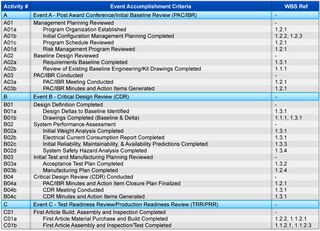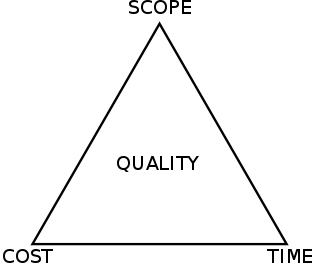Project management is the process of leading the work of a team to achieve goals and meet success criteria at a specified time. The primary challenge of project management is to achieve all of the project goals within the given constraints. This information is usually described in project documentation, created at the beginning of the development process. The primary constraints are scope, time, budget. The secondary challenge is to optimize the allocation of necessary inputs and apply them to meet pre-defined objectives.

A work-breakdown structure (WBS) in project management and systems engineering, is a deliverable-oriented breakdown of a project into smaller components. A work breakdown structure is a key project deliverable that organizes the team's work into manageable sections. The Project Management Body of Knowledge defines the work-breakdown structure as a "hierarchical decomposition of the total scope of work to be carried out by the project team to accomplish the project objectives and create the required deliverables."

The waterfall model is a breakdown of project activities into linear sequential phases, where each phase depends on the deliverables of the previous one and corresponds to a specialization of tasks. The approach is typical for certain areas of engineering design. In software development, it tends to be among the less iterative and flexible approaches, as progress flows in largely one direction through the phases of conception, initiation, analysis, design, construction, testing, deployment and maintenance.

In computer science, a thread of execution is the smallest sequence of programmed instructions that can be managed independently by a scheduler, which is typically a part of the operating system. The implementation of threads and processes differs between operating systems, but in most cases a thread is a component of a process. Multiple threads can exist within one process, executing concurrently and sharing resources such as memory, while different processes do not share these resources. In particular, the threads of a process share its executable code and the values of its dynamically allocated variables and non-thread-local global variables at any given time.
Contemporary business and science treat a project as any undertaking, carried out individually or collaboratively and possibly involving research or design, that is carefully planned to achieve a particular aim.
In information technology and computer science, especially in the fields of computer programming, operating systems, multiprocessors, and databases, concurrency control ensures that correct results for concurrent operations are generated, while getting those results as quickly as possible.
The Rational Unified Process (RUP) is an iterative software development process framework created by the Rational Software Corporation, a division of IBM since 2003. RUP is not a single concrete prescriptive process, but rather an adaptable process framework, intended to be tailored by the development organizations and software project teams that will select the elements of the process that are appropriate for their needs. RUP is a specific implementation of the Unified Process.
Implementation is the realization of an application, or execution of a plan, idea, model, design, specification, standard, algorithm, or policy.

In systems engineering, information systems and software engineering, the systems development life cycle (SDLC), also referred to as the application development life-cycle, is a process for planning, creating, testing, and deploying an information system. The systems development life cycle concept applies to a range of hardware and software configurations, as a system can be composed of hardware only, software only, or a combination of both. There are usually six stages in this cycle: requirement analysis, design, development and testing, implementation, documentation, and evaluation.
ISO/IEC/IEEE 12207Systems and software engineering – Software life cycle processes is an international standard for software lifecycle processes. First introduced in 1995, it aims to be a primary standard that defines all the processes required for developing and maintaining software systems, including the outcomes and/or activities of each process.
Filmmaking is the process by which a film is made. It's a non-linear methodology that evolved from the practical experiences in its beginnings, which was framed by what technology would allow; initially cameras holding only 10 minutes of negative raw stock at a time yet easily mobile. The methodology allowed for shots to be repeated as often as necessary for best performance and scenes shot out of order for the advantage of convenience and economics. The process is used today in the making of theatrical films, films made for cable, terrestrial television, streaming platforms, and is a process familiar to making documentaries, music videos, and student films. Filmmaking involves a number of complex and discrete stages including an initial story, idea, or commission, through screenwriting, casting, shooting, sound recording and pre-production, editing, and screening the finished product before an audience that may result in a film release and an exhibition. Filmmaking takes place in many places around the world in a range of economic, social, and political contexts, and using a variety of technologies and cinematic techniques.
The Personal Software Process (PSP) is a structured software development process that is designed to help software engineers better understand and improve their performance by bringing discipline to the way they develop software and tracking their predicted and actual development of the code. It clearly shows developers how to manage the quality of their products, how to make a sound plan, and how to make commitments. It also offers them the data to justify their plans. They can evaluate their work and suggest improvement direction by analyzing and reviewing development time, defects, and size data. The PSP was created by Watts Humphrey to apply the underlying principles of the Software Engineering Institute's (SEI) Capability Maturity Model (CMM) to the software development practices of a single developer. It claims to give software engineers the process skills necessary to work on a team software process (TSP) team.
In time management, timeboxing allocates a fixed time period, called a timebox, within which planned activity takes place. It is used by several project management approaches and for personal time management.
A distributed algorithm is an algorithm designed to run on computer hardware constructed from interconnected processors. Distributed algorithms are used in many varied application areas of distributed computing, such as telecommunications, scientific computing, distributed information processing, and real-time process control. Standard problems solved by distributed algorithms include leader election, consensus, distributed search, spanning tree generation, mutual exclusion, and resource allocation.

The Unified Software Development Process or Unified Process is an iterative and incremental software development process framework. The best-known and extensively documented refinement of the Unified Process is the Rational Unified Process (RUP). Other examples are OpenUP and Agile Unified Process.

In the United States Department of Defense, the Integrated Master Plan (IMP) and the Integrated Master Schedule (IMS) are important program management tools that provide significant assistance in the planning and scheduling of work efforts in large and complex materiel acquisitions. The IMP is an event-driven plan that documents the significant accomplishments necessary to complete the work and ties each accomplishment to a key program event. The IMP is expanded to a time-based IMS to produce a networked and multi-layered schedule showing all detailed tasks required to accomplish the work effort contained in the IMP. The IMS flows directly from the IMP and supplements it with additional levels of detail——both then form the foundations to implement an Earned Value Management System.
A glossary of terms relating to project management and consulting.

The project management triangle is a model of the constraints of project management. While its origins are unclear, it has been used since at least the 1950s. It contends that:
- The quality of work is constrained by the project's budget, deadlines and scope (features).
- The project manager can trade between constraints.
- Changes in one constraint necessitate changes in others to compensate or quality will suffer.
A phase-gate process is a project management technique in which an initiative or project is divided into distinct stages or phases, separated by decision points.
The following outline is provided as an overview of and topical guide to project management:






